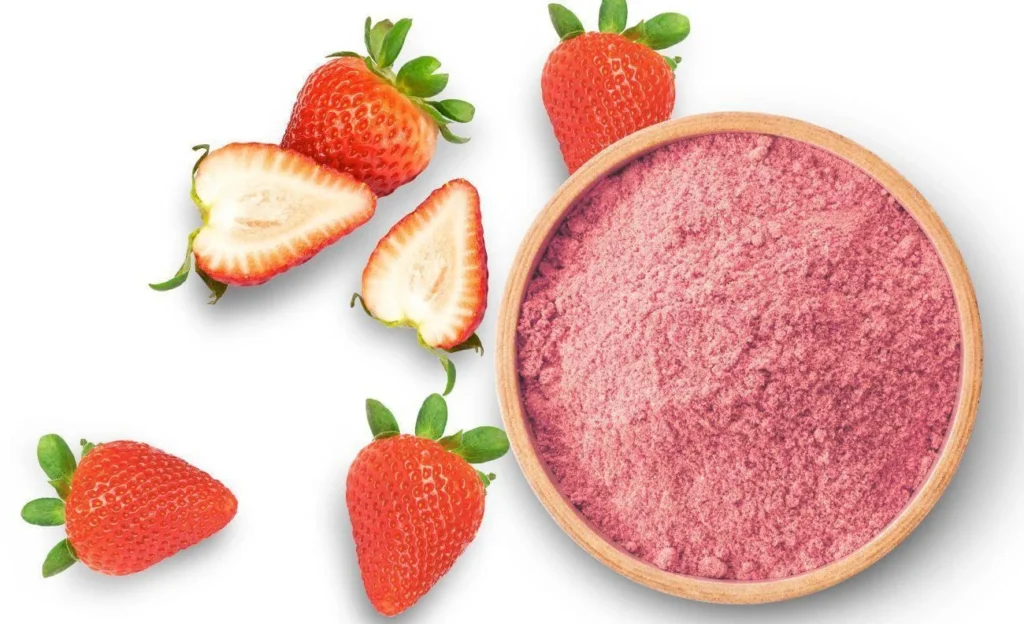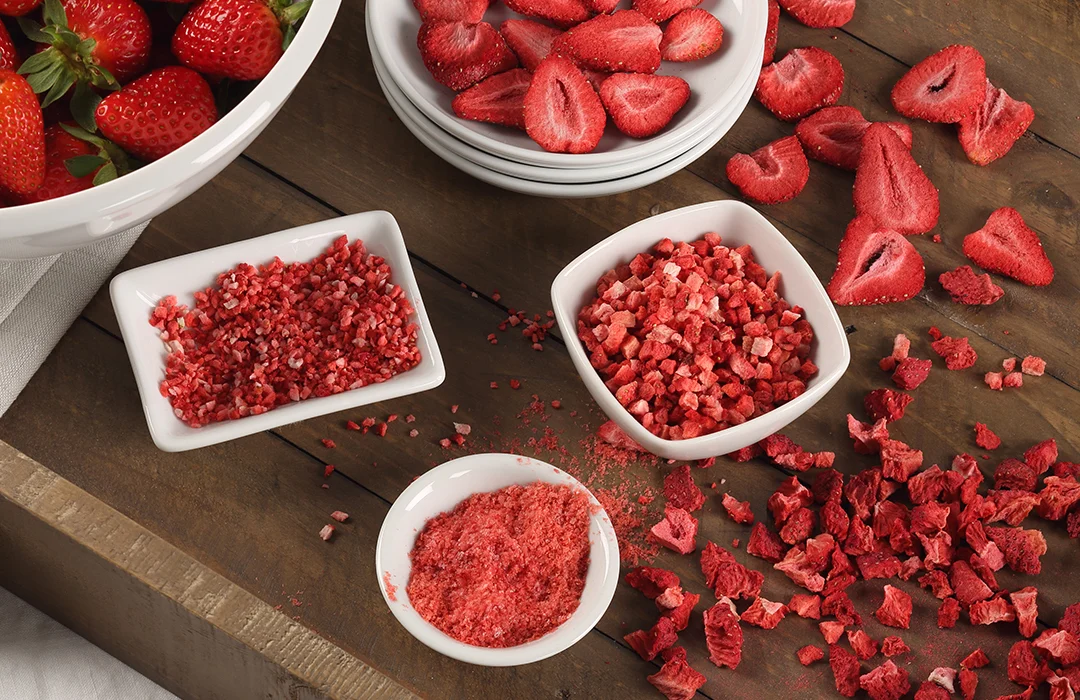Strawberries are widely appreciated for their vibrant color, sweet-tart flavor, and impressive antioxidant content. As consumer interest in natural ingredients grows, strawberry-derived products have become increasingly common in the food, supplement, and cosmetics industries. Two of the most popular forms are strawberry powder and freeze-dried strawberries. Though both are made from the same fruit, their characteristics, production methods, and best-use scenarios differ significantly. This article explores how they compare and which one might suit your specific formulation or consumption needs.
What Is Strawberry Powder?
Production Method
Strawberry powder is typically made using a spray-drying technique. Fresh strawberries are first juiced or pureed, then the liquid is sprayed into a hot-air chamber, where water is quickly evaporated, leaving behind fine, pink powder. The result is a shelf-stable, free-flowing product that retains much of the flavor and aroma of the original fruit.
Applications
Because of its excellent solubility and fine texture, strawberry powder is widely used in powdered drink mixes, capsules, protein blends, meal replacement shakes, and even natural cosmetic products. A good example of this form is the strawberry powder from BSTBIO, which is spray-dried and designed for high-volume food and supplement applications.
What Are Freeze-Dried Strawberries?
Production Method
Freeze-drying involves freezing the strawberries and then reducing the surrounding pressure to allow the frozen water in the fruit to sublimate directly from ice to vapor. This method preserves much of the fruit’s cellular structure, color, and nutrient profile, resulting in crispy, airy pieces that resemble the original fruit more closely than other drying methods.
Applications
Freeze-dried strawberries are commonly used as snacks, toppings for cereal and yogurt, and ingredients in baking. They’re also crushed into powders for use in desserts and confectionery products where intense fruit flavor is desired.
Nutritional Comparison
Vitamin C and Antioxidants
Freeze-dried strawberries tend to retain more heat-sensitive nutrients like vitamin C and certain polyphenols. Spray drying, by contrast, exposes the fruit to higher temperatures, which may result in partial degradation of some micronutrients, though antioxidants like anthocyanins can still be preserved.
Sugar and Fiber Content
Both forms maintain the natural sugars and fiber of the original fruit, though freeze-dried pieces may contain slightly higher concentrations per gram due to minimal carrier content and no added processing agents.
Texture and Solubility
Strawberry powder is prized for its smooth, free-flowing consistency and immediate solubility in both hot and cold liquids, making it ideal for drink mixes and reconstitution. In contrast, freeze-dried strawberries are dry, crunchy, and do not dissolve, but instead rehydrate slowly, which is suitable for culinary uses requiring texture.
Flavor and Color
Freeze-dried strawberries retain a more intense, fresh-like aroma and tartness, while strawberry powder tends to be milder and more uniform in taste, especially if produced from juice rather than pulp. The color of freeze-dried fruit is also brighter, whereas spray-dried powder is typically light pink and homogeneous.
Shelf Life and Storage
Both forms are shelf-stable when stored correctly, but are hygroscopic—meaning they readily absorb moisture from the air. Strawberry powder should be stored in airtight packaging away from humidity and light. Freeze-dried products require sealed containers with desiccants to maintain crispness and prevent spoilage.
Cost and Availability
Spray-dried strawberry powder is generally more economical to produce and scale, making it cost-effective for large-volume manufacturing. Freeze-dried strawberries are more labor-intensive and energy-intensive to produce, thus commanding a higher market price.
Suitability by Application
| Application | Best Choice | Reason |
|---|---|---|
| Beverages | Strawberry Powder | Soluble and blends easily |
| Capsules/Supplements | Strawberry Powder | Fine texture suitable for encapsulation |
| Snack Products | Freeze-Dried | Crunchy texture and fresh taste |
| Yogurt & Cereal Toppings | Freeze-Dried | Visual appeal and texture enhancement |
| Cosmetics | Strawberry Powder | Easy to mix with creams and masks |
Environmental Considerations
Freeze-drying is more energy-intensive than spray-drying, both in terms of equipment and operation. Spray drying consumes less electricity and is more scalable in high-volume production environments. In terms of logistics, strawberry powder is lighter and more compact, resulting in reduced shipping costs and carbon footprint per unit of active ingredient.
Both strawberry powder and freeze-dried strawberries have their unique strengths and limitations. If your focus is on solubility, affordability, and compatibility with beverages or supplement blends, strawberry powder is a more functional choice. On the other hand, if texture, flavor intensity, and visual appeal are critical—such as in snack foods or decorative toppings—freeze-dried strawberries are ideal.
Ultimately, the better option depends on your specific application, budget, and formulation goals. Understanding the differences will help you make an informed decision for product development or daily use.


